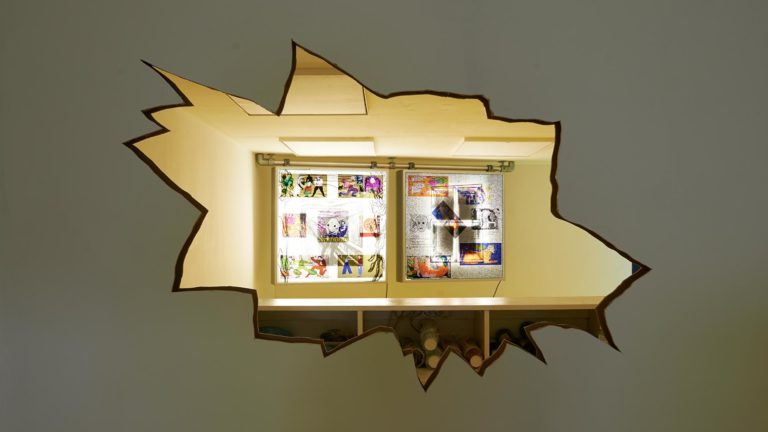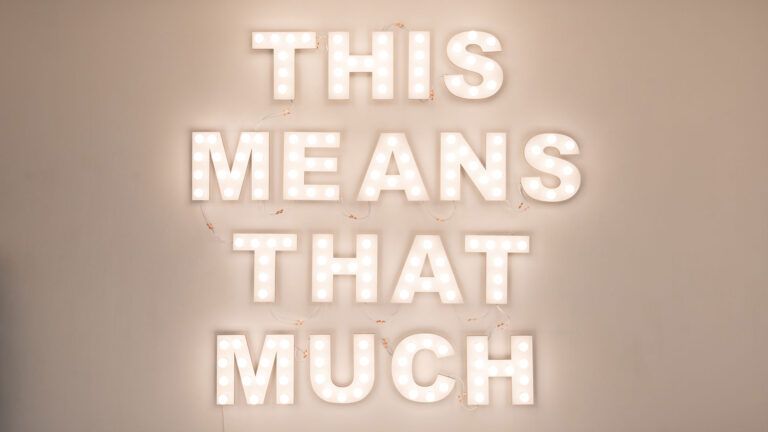Artist: Adrien Lucca
Exhibition title: Mémoire #2 White light researches/white light demons/white light demos
Venue: Rib, Rotterdam, The Netherlands
Date: November 18, 2017 – January 20, 2018
Photography: Jeroen Laven / all images copyright and courtesy of the artist and Rib, Rotterdam
It seems that, in itself, Light is not colored and that it is shadow that causes its colors; and that the Blue and the violet are in some way more colors than the Red and the Yellow; and red more than Yellow […]*
-Louis-Bertrand Castel (1743)[1]
From the medieval times to the 19th Century, many western color theories relied on the belief that colors could be explained by their appearances. The belief that the mechanisms behind colors could be understood by visual judgments only, belief that all the elements for understanding light and colors were, somehow, accessible to our senses and logic. Before Newton’s experiments with prisms and sunlight became famous during the 18th Century – revealing new physical relationships between light, matter and colors –, scholars were describing colors as “mixtures” of light and shadow, following Aristotle’s teachings. Visual phenomena were described according to this model that explained why some colors seem to be intrinsically dark (blue, violet, black, shadow-like), while other colors always seemed light (orange, yellow, white, light-like). One can easily imagine how – by the force of symbols, law and imagination – light and shadow, attributed to colors in diverse proportions to explain their appearance, could become the ground for philosophical or religious interpretations, the basis for using certain colors as symbols of political power, or for the attribution of magical properties to colors.
But from the 17th Century onwards, a color science was developed on a paradigm shift: a physical theory in which the concept of “shadow” having an influence on light was a nonsense. shadow, the absence of any light, couldn’t explain anything. Instead, modern white lights – sunlight, daylight, flame light, moonlight, electric light – are all compounds of colored light rays: blends of radiations impacting our eyes, giving us the sensation of white when illuminating white objects. Their components are not sensed but hidden behind the visual appearance of white light and white objects. A whole new explanation for the physical causes of colors was on its way: explaining colors by invisible but measurable means – such as the absorption of certain lights by matter and the specific reactions of visual organs to light –, explanation that did not involve magic but physics, mathematics and physiology.
Since the causes of colors depend on invisible mechanisms, a demon that understands and controls the non-visual parameters behind color vision can now play with a keyboard of light effects to do magic tricks. These tricks or “demos” are even possibly beautiful, pleasing and surprising. They can make us laugh, happy or anxious but in any case, they touch the very foundations of our visual universe: what if I can sense the world in a completely different manner? Can the techniques of the demon – who is neither a real scientist nor a real magician – open-up a space for experiencing, enjoying and criticizing our intimate visions and beliefs?
White light is a recurrent theme in Adrien Lucca’s work, from the drawings of the D65 studies (2011-2014) where he started to use color science, pigments and “daylight” to make artworks, to Microkosmos (2017-2018) an installation that will be inaugurated in Brussels in 2018, where a special white light transforms the colors of the objects illuminated by it, giving a very counter-intuitive color-blinding effect. Around this recurring theme of white light, Rib will present a selection of artworks, documents and light apparatuses about the study and the use of white light and colors in Lucca’s art practice for the last 7 years.
* Le vrai système de physique Générale de M. Isaac Newton, exposé et analyse en parallèle avec celui de Descartes ; à la portée du commun des Physiciens. R. P. Louis Castel, Claude-François Simon ed., Paris, 1743
Adrien Lucca(Paris, 1983) studied in Brussels at the École de Recherche Graphique and was a resident at the Jan Van Eyck Academie in Maastricht (2010-11). Recent exhibitions include été 78, Brussel (2017); LEVY.DELVAL, Brussel (2016); IKOB, Eupen (2014) en in De Elektriciteitscentrale, Brussel (2014). Lucca teaches color-theory in Brussels at the École Nationale Supérieure des Arts Visuels de La Cambre
Kindly supported by Gemeente Rotterdam, Mondriaan Fund and Stichting Verzameling van Wijngaarden-Boot
Adrien Lucca, Mémoire #2 White light researches/white light demons/white light demos, 2017-2018, exhibition view, Rib, Rotterdam
Adrien Lucca, Study n°2 – gradients/disappearances, 2012, Pigments and pencil on paper, From the D65 series, This hand-made color study is calibrated on a scientific model of daylight called “illuminant D65”. Every painted object is a different attempt at synthesizing, on average, the same light grey color. The position of every single line has been computed in a spreadsheet program
Adrien Lucca, Study n°2 – gradients/disappearances, 2012, Pigments and pencil on paper, From the D65 series, This hand-made color study is calibrated on a scientific model of daylight called “illuminant D65”. Every painted object is a different attempt at synthesizing, on average, the same light grey color. The position of every single line has been computed in a spreadsheet program
Adrien Lucca, Study n°2 – gradients/disappearances, 2012, Pigments and pencil on paper, From the D65 series, This hand-made color study is calibrated on a scientific model of daylight called “illuminant D65”. Every painted object is a different attempt at synthesizing, on average, the same light grey color. The position of every single line has been computed in a spreadsheet program
Adrien Lucca, Pattern n°3 – phthalocyanine Blue-green/pyrrole Red, 2016, Pigments and pencil on paper, From the Wave patterns series, Painted by hand and with a stencil, this drawing made of two complementary colors is also calibrated on daylight. The pattern is the product of two superimposed sine waves and of their interference.
Adrien Lucca, Preuves de concept and Quatre mouvements, 2016, Application file, project Entrelacs quasi-cristallins, Two elements of the application file for the final step of the competition for the creation of new windows in the 12th Century church of Sylvanès, France; Mémoire d’atelier , 2017, Edition JAP, Brussels, Artist’s book, A book containing a theoretical discussion and two chapters retracing the story behind the construction of the projects Soleil de minuit and Entrelacs quasi-cristallins; Microkosmos, 2017, Book draft, project Microkosmos, The beginning of the text of a future book about the project Microkosmos, containing historical and theoretical considerations about light and art.
Adrien Lucca, Preuves de concept and Quatre mouvements, 2016, Application file, project Entrelacs quasi-cristallins, Two elements of the application file for the final step of the competition for the creation of new windows in the 12th Century church of Sylvanès, France; Mémoire d’atelier , 2017, Edition JAP, Brussels, Artist’s book, A book containing a theoretical discussion and two chapters retracing the story behind the construction of the projects Soleil de minuit and Entrelacs quasi-cristallins; Microkosmos, 2017, Book draft, project Microkosmos, The beginning of the text of a future book about the project Microkosmos, containing historical and theoretical considerations about light and art.
Adrien Lucca, Stained-glass prototype, 2016, Transparent and opal Antique glass, grisaille, steel frame, From the project Entrelacs quasi-cristallins, This prototype window was built in the context of a competition for the creation of new windows in the 12th century church of Sylvanès, France. It is designed to radically change its visual appearance during the course of one day. Illuminated by daylight it is a colorful, geometric composition, while under direct sunlight it becomes black and white
Adrien Lucca, Stained-glass prototype, 2016, Transparent and opal Antique glass, grisaille, steel frame, From the project Entrelacs quasi-cristallins, This prototype window was built in the context of a competition for the creation of new windows in the 12th century church of Sylvanès, France. It is designed to radically change its visual appearance during the course of one day. Illuminated by daylight it is a colorful, geometric composition, while under direct sunlight it becomes black and white
Adrien Lucca, Stained-glass prototype, 2016, Transparent and opal Antique glass, grisaille, steel frame, From the project Entrelacs quasi-cristallins, This prototype window was built in the context of a competition for the creation of new windows in the 12th century church of Sylvanès, France. It is designed to radically change its visual appearance during the course of one day. Illuminated by daylight it is a colorful, geometric composition, while under direct sunlight it becomes black and white
Adrien Lucca, Contrast and Chroma, 2015, Two glass prototypes, Epoxy-laminated Antique glass on diffusive laminated float glass, From the project Soleil de minuit , Soleil de minuit is a permanent, monumental glass installation in the metro station Place d’Armes in Montreal, Canada. These two prototypes were necessary for testing two different algorithmic solutions for applying colormanagement techniques to the medium of glass. The colors of the round shapes are replicating the color of sunlight
Adrien Lucca, Contrast and Chroma, 2015, Two glass prototypes, Epoxy-laminated Antique glass on diffusive laminated float glass, From the project Soleil de minuit , Soleil de minuit is a permanent, monumental glass installation in the metro station Place d’Armes in Montreal, Canada. These two prototypes were necessary for testing two different algorithmic solutions for applying colormanagement techniques to the medium of glass. The colors of the round shapes are replicating the color of sunlight
Adrien Lucca, Dual-band Special-white lamps, 2017, Red-orange and Cyan LEDs, aluminum body, DMX controller, cables, From the project Microkosmos, Next year, these four lamps will be permanently installed in the courtyard of the community center Het Huys in Brussels. While matching the yellowish-white color of halogen lamps, the light that comes out of these lamps amplifies some colors while it fades others and causes major hue-shift. One could describe this light as an artificial mean to experience color-blindness.
Adrien Lucca, Dual-band Special-white lamps, 2017, Red-orange and Cyan LEDs, aluminum body, DMX controller, cables, From the project Microkosmos, Next year, these four lamps will be permanently installed in the courtyard of the community center Het Huys in Brussels. While matching the yellowish-white color of halogen lamps, the light that comes out of these lamps amplifies some colors while it fades others and causes major hue-shift. One could describe this light as an artificial mean to experience color-blindness.




















